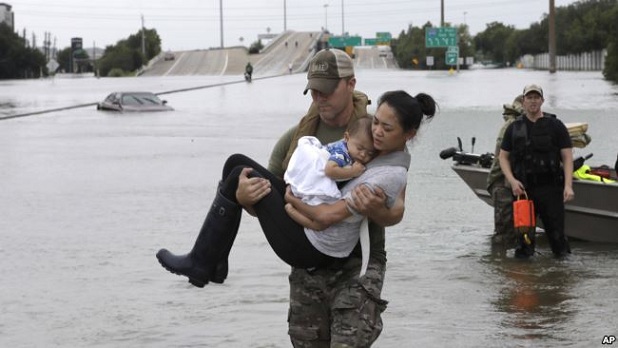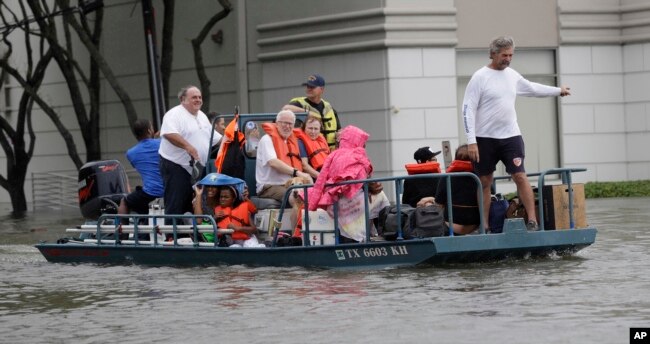
Houston, the fourth largest U.S. city, and large parts of southeastern Texas are under water, overwhelmed by tropical storm rains of historic proportions, and the heavy rain resumed Sunday night, making rescuers’ tasks more difficult.
Hundreds of rescue operations have been underway throughout the area — by helicopter, by boat, by rescue crews churning through floodwaters on foot. Volunteers have joined emergency workers — police, fire and medical crews — and 3,000 National Guard members ordered to do what they can to “protect human life.”
Tragic discoveries may be yet to come in small towns and remote areas cut off from all outside contact by the catastrophic floods spawned by the storm system. But since Hurricane Harvey — now weakened to a tropical storm — swept ashore from the Gulf of Mexico Friday night, remarkably few casualties have been reported.
The storm’s danger has been magnified by its unusual path. Once on-shore, the swirling weather system has moved extremely slowly. It has been refueled by moisture from the warm waters of the Gulf and has continued to pour down rain at an extraordinarily heavy rate. Every major highway into and out of Houston has become a river, and the city’s two airports are closed.
“It’s impossible not to feel overwhelmed,” VOA’s Celia Mendoza said Sunday from Houston. She and other reporters trying to chronicle the tragedy wound up needing rescue themselves as the floods spread.
Houston Mayor Sylvester Turner said it was not possible to overcome logistical obstacles to a large-scale evacuation. He defended his actions at a news conference late Sunday, saying it would have been “crazy” to attempt a mass movement of millions of people on such short notice.
Up to 65 centimeters of rain has already fallen over much of the area around Houston, meteorologists said, but that total may double by Friday.
Turner asked where the 6 million residents of Houston and its suburbs could have gone, since the city is by far the biggest population center in that part of Texas, the second largest U.S. state. The mayor said his decision not to order an evacuation was smart and in the best interest of Houstonians.
For those stranded in flooded parts of the city, emergency officials said no one should seek refuge in the attics of their homes, due to a risk that water rising to record levels would trap them in an enclosed area. The advice to all was simple: climb onto the roof and try to attract attention by waving a white cloth.
Twenty-two aircraft were in the skies over Houston and its surroundings Sunday, trying to keep up with constant calls for help and searching for people marooned atop their homes. Helicopter rescues were common, and authorities had hundreds of boats out searching for flood victims. Some people managed to escape the flooded areas by kayak, canoe or inflatable rafts.
People who thought they might be able to walk to safety through water only waist- or chest-deep in their neighborhoods were warned to resist the urge to test strong currents.
Remarkably, the confirmed death toll had not risen beyond two people by Sunday evening, but authorities said both casualties and damage are expected to climb.
President Donald Trump will visit the disaster area Tuesday, White House officials said, but only if it is clear that his trip will not disrupt relief efforts.
The latest forecast from the National Hurricane Center warned of “unprecedented” and catastrophic life-threatening floods across southeast Texas. The National Weather Service said “the breadth and intensity of this rainfall is beyond anything experienced before.”
Heavy thunderstorms were expected over parts of Houston late Sunday night and into Monday, and meteorologists warned tornadoes also were likely.
In Photos:
Summarizing the range of problems confronting rescuers Sunday, Texas Governor Greg Abbott said he was deeply grateful to his fellow Americans for their support and resources, particularly what he called a “very effective federal partner” that has granted every request for aid.
The White House said President Trump led a Cabinet meeting about the storm disaster, and that he expects all federal agencies to stay fully committed to helping state officials in Texas and neighboring Louisiana.
Federal Emergency Management Agency chief Brock Long told CNN television that members of his agency will be involved in operations in storm-damaged areas “for years.” He called the devastation caused by Hurricane Harvey a “landmark event.”
Several Houston-area oil refineries shut down on Sunday as the storm continued. The closures take roughly 12 percent of U.S. fuel-making capacity offline, compounding concerns about fuel shortages in coming days.
Harvey was the strongest hurricane to hit the United States mainland in more than a decade.
Source – VOA


